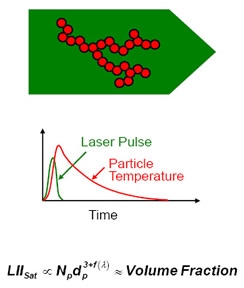Laser Induced Incandescence
 Laser-induced incandescence (LII) is a technique in which a powerful laser beam or sheet is used to superheat soot primary particles up to 5000 K. The resulting incandescence is typically collected either with a photomultiplier tube for capturing the time-dependent signal, or with an intensified CCD camera for capturing two-dimensional images.
Laser-induced incandescence (LII) is a technique in which a powerful laser beam or sheet is used to superheat soot primary particles up to 5000 K. The resulting incandescence is typically collected either with a photomultiplier tube for capturing the time-dependent signal, or with an intensified CCD camera for capturing two-dimensional images.
Fig. 1. Schematic of LII process showinglaser sheet heating of soot primary particles.
As shown in Fig. 1, a short laser pulse (typ. 10 ns) is followed by a period of incandescence that lasts 200 to 1000 nanoseconds. Because the smaller particles will decay faster than larger particles, the characteristics of the time decay can be used to extract information about size distributions. For volume fraction imaging, it is possible to operate in a saturated regime for which the LII signal is more or less independent of laser energy and only dependent upon the particle density times the particle diameter to the third power. Calibration against a known particle distribution and careful attention to laser characteristics enables quantitative measurements. LII systems do not require tunable lasers and are often operated using the fundamental (1064 nm) or frequency doubled (532 nm) output of a pulsed Nd:YAG laser. Hence, this technique is readily implemented in laboratories that already have such lasers and detection equipment available. However, for precise measurements, careful attention must be paid to the laser-pulse temporal and spatial profiles in each particular laboratory.
